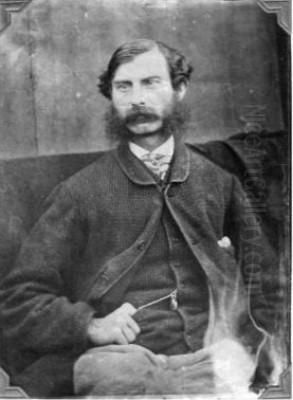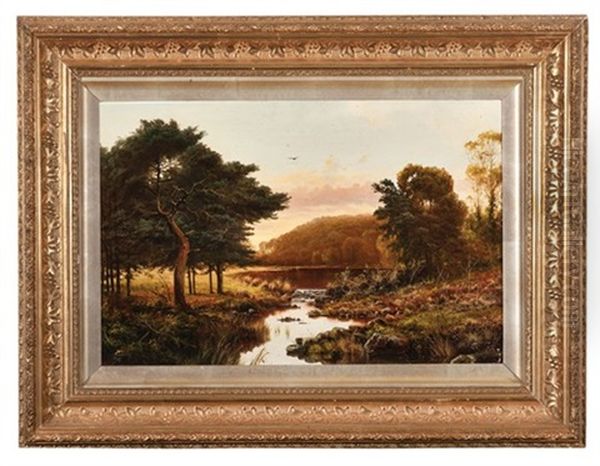
James Haughton Forrest stands as a significant figure in nineteenth and early twentieth-century Australian art, particularly renowned for his detailed and evocative depictions of the Tasmanian landscape and coastline. Active during a period of colonial expansion and burgeoning national identity, Forrest's work provides a valuable visual record of Tasmania's natural environment, rendered with meticulous care and a keen eye for atmospheric effect. His life, marked by international experiences and diverse roles before settling into his artistic career in Tasmania, shaped his unique perspective and contributed to the distinct character of his paintings. Born in 1826 and passing away in 1925, his long life spanned a transformative era in both European and Australian history and art.
An Adventurous Early Life
James Haughton Forrest's beginnings were far removed from the Tasmanian wilderness he would later immortalise. He was born in Mosman, near Paris, France, in 1826. His family background was connected to British establishment circles; his father, Thomas Forrest, served as an aide-de-camp to the Lord Lieutenant of Ireland and later became a Member of Parliament for Wells in the UK. James was one of ten children born to Thomas and his wife, Eleanor. The political turbulence of the era directly impacted the family; the French Revolution of 1830 compelled them to leave France.
Their journey then took them across the Atlantic to Jamaica, where the family had interests in sugar plantations. This exposure to different cultures and environments during his formative years likely broadened the young Forrest's horizons. His formal education included a period at a military college in Wiesbaden, Germany, suggesting an initial path perhaps oriented towards service rather than art. He subsequently served, albeit briefly, in the Royal Monmouthshire Light Infantry militia in Britain, eventually attaining the rank of Captain. This varied background – encompassing European aristocracy, colonial plantation life, and military training – provided a rich tapestry of experience before he turned his focus fully towards art.
The Move to Van Diemen's Land

The pivotal moment in Forrest's life and artistic career came with his decision to emigrate to Australia. He arrived in Tasmania, then still often referred to as Van Diemen's Land, in 1876. This move marked a definitive shift towards the life for which he is now remembered. Shortly after his arrival, he secured a significant land grant of 100 acres (approximately 40 hectares) near St Marys, situated in the northeast of the island. This immersion in the Tasmanian environment provided him with direct access to the landscapes that would become his primary subject matter.
His engagement with Tasmanian society extended beyond land ownership and art. Forrest took on civic responsibilities, serving for a time as the Police Magistrate in the town of Sorell, located southeast of Hobart. This role would have given him further insight into the colonial society and the diverse terrain of the region. It was in Tasmania that he married Martha Elleston. His life became firmly rooted in the island colony, providing the stability and inspiration for his most productive artistic period.
Forging an Artistic Path in Tasmania
While details of his early artistic training remain somewhat scarce, it was in Tasmania that James Haughton Forrest truly established himself as a professional painter. He dedicated himself primarily to landscape and marine subjects, finding endless inspiration in the island's dramatic coastlines, rugged mountains, dense forests, and changeable weather. His approach was characterised by a commitment to realism and a remarkable attention to detail, setting him apart from artists who might favour broader, more stylised interpretations of nature.
Forrest developed a distinctive style that aimed for topographical accuracy combined with atmospheric sensitivity. He meticulously rendered the textures of rock formations, the intricate patterns of foliage, and the subtle play of light and shadow across the land and sea. This dedication to detail suggests a deep observation of the natural world, perhaps influenced by the scientific curiosity prevalent in the Victorian era. His works sought to capture not just the appearance of the Tasmanian landscape, but also its unique character and mood.
Master of the Tasmanian Landscape
Forrest's reputation largely rests on his masterful depictions of the Tasmanian wilderness. He travelled extensively around the island, sketching and painting scenes that ranged from the settled environs of Hobart to the remote and untamed regions of the west coast. His landscapes often convey a sense of grandeur and solitude, reflecting the powerful impact of nature on the human spirit. Works such as Tasmanian Landscape exemplify his ability to capture the specific light and atmosphere of the island, rendering mountains, water, and vegetation with precision.
His painting Hobart Town with Mount Wellington in the Background is another key example, showcasing his skill in combining detailed topographical representation with a broader scenic view. He carefully delineates the features of the nascent city while capturing the imposing presence of the mountain (kunanyi/Mount Wellington) that dominates its backdrop. Unlike the idealised classical landscapes of artists like Claude Lorrain, or the sometimes-dramatic interpretations of the Sublime by earlier Romantics, Forrest generally pursued a more direct, albeit carefully composed, realism.
His approach can be compared to other colonial Australian landscape painters. While Eugene von Guérard brought a meticulous, almost scientific, Germanic precision to his Australian scenes, and Louis Buvelot introduced a softer, more atmospheric approach influenced by the Barbizon School, Forrest carved his own niche with his highly detailed yet evocative Tasmanian views. He shared with John Glover, an earlier prominent painter of Tasmania, a fascination with the island's unique light and vegetation, though Forrest's style is generally tighter and more detailed than Glover's broader, pastoral approach.
The Lure of the Sea: Marine Paintings
Alongside his landscapes, James Haughton Forrest was a prolific painter of marine subjects. Tasmania's identity as an island, with its busy ports, dramatic coastline, and maritime traffic, provided ample inspiration. His seascapes often depict ships navigating challenging waters, capturing the dynamic interplay between vessels and the elements. These works demonstrate his skill in rendering the movement of water, the complex rigging of sailing ships, and the dramatic effects of light on the sea and sky.
A notable example is Ships in a Storm. Such works align with the tradition of Romantic marine painting, evoking the power and unpredictability of nature, reminiscent of the dramatic seascapes of British master J.M.W. Turner or the turbulent energy found in works by French Romantic Eugène Delacroix. Forrest captured the tension and drama of maritime life, appealing to an audience familiar with the importance and dangers of sea travel in the colonial era. Other marine specialists, like the later British painter Montague Dawson, also aimed for high realism in ship portraits, though Forrest's work often incorporated more dramatic environmental settings.
However, some critics have noted occasional perceived inaccuracies in the technical details or positioning of ships in Forrest's marine paintings. It has been suggested that some of these compositions might have been assembled from secondary sources or photographs rather than direct observation of specific maritime events, particularly concerning complex sailing manoeuvres or historical accuracy. This critique highlights a tension sometimes found in highly detailed realism – the potential conflict between meticulous rendering and authentic, first-hand experience. Despite this, his marine works remain popular for their visual impact and detailed execution.
Collaboration with John Watt Beattie
An interesting aspect of Forrest's career was his collaboration with the renowned Tasmanian photographer John Watt Beattie. Beattie was instrumental in documenting Tasmania's landscape, people, and history through photography in the late 19th and early 20th centuries. Forrest worked with Beattie, often hand-colouring Beattie's photographic prints of Tasmanian scenes. This collaboration was mutually beneficial: it provided Forrest with income and potentially source material or detailed studies for his paintings, while adding artistic value and popular appeal to Beattie's photographs.
This intersection of painting and photography reflects a broader trend in the 19th century. Photography was increasingly used by artists as a tool for capturing detail and composing scenes, although attitudes towards its use varied. Some artists, like Edgar Degas or Thomas Eakins, openly embraced photography as an aid, while others were more circumspect. Forrest's work with Beattie suggests an openness to utilising modern technologies to enhance the documentation and representation of the Tasmanian environment. It likely reinforced his commitment to detailed accuracy, aligning with the perceived objectivity of the photographic lens.
Artistic Philosophy and Technique
James Haughton Forrest's artistic philosophy appears rooted in a deep respect for the natural world and a desire to represent it faithfully. Sources suggest he consciously positioned himself against what he perceived as the over-simplification or excessive emotionalism of some Romantic painters. Instead, he believed in the power of accumulated detail to convey truth and beauty. His method involved careful observation, possibly aided by sketches and potentially photographs, which were then meticulously translated onto canvas in the studio.
His technique involved precise brushwork, careful layering of colours to achieve depth and luminosity, and a sophisticated understanding of light effects. He captured the clarity of Tasmanian air, the reflections on water, and the textures of diverse natural surfaces. While contemporary movements like Impressionism were revolutionising art in Europe, with artists like Claude Monet and Camille Pissarro focusing on capturing fleeting moments of light and colour with looser brushwork, Forrest remained committed to a more traditional, detailed realism. His approach aligned more closely with the detailed naturalism seen in some aspects of the Pre-Raphaelite Brotherhood in Britain or the Hudson River School painters like Albert Bierstadt and Frederic Edwin Church in America, who also depicted majestic landscapes with considerable detail.
Exhibitions, Recognition, and Legacy
Throughout his long career, James Haughton Forrest achieved considerable recognition. He exhibited his work regularly in Tasmania, mainland Australia, and even overseas. He participated in exhibitions organised by bodies such as the Art Society of Tasmania and the Victorian Academy of Arts in Melbourne. His paintings were acquired by major public collections, including state galleries, ensuring their visibility and preservation for future generations. His work was popular with the public, who appreciated his recognisable and skillfully rendered views of familiar Tasmanian locales.
Forrest is now regarded as one of the most important Tasmanian artists of the colonial and early post-Federation period. His prolific output provides an invaluable historical record of the island's landscape at a time before significant modern development. He captured views of wilderness areas, coastal scenery, and developing settlements, offering insights into the environment and colonial life of 19th and early 20th century Tasmania. His dedication to his adopted home and his distinctive artistic style secured his place in the narrative of Australian art history. Other Australian colonial artists like Conrad Martens, known for his watercolours of Sydney and surrounds, similarly documented the developing colonies, but Forrest's focus remained intensely Tasmanian.
Later Life and Enduring Influence
James Haughton Forrest continued painting into his old age, remaining active well into the 20th century. He lived a remarkably long life, passing away in Melton Mowbray, Tasmania, in 1925, just shy of his hundredth birthday. By the time of his death, the art world had undergone significant transformations, with modernism making inroads globally. However, Forrest's work retained its appeal, valued for its technical skill, its connection to place, and its historical significance.
His legacy endures through his numerous paintings held in public and private collections. They continue to be admired for their detailed beauty and as evocative representations of Tasmania's unique natural heritage. While perhaps not an innovator in the mould of European modernists, Forrest excelled within his chosen field of realistic landscape and marine painting. He stands as a key figure who helped shape the visual identity of Tasmania, leaving behind a rich and detailed chronicle of the island's enduring beauty. His work offers a window into a specific time and place, rendered by an artist deeply engaged with his environment.